When Food Stops Being ‘Authentic’—and Why That’s OK
From childhood sushi lies to $500 omakase dreams.
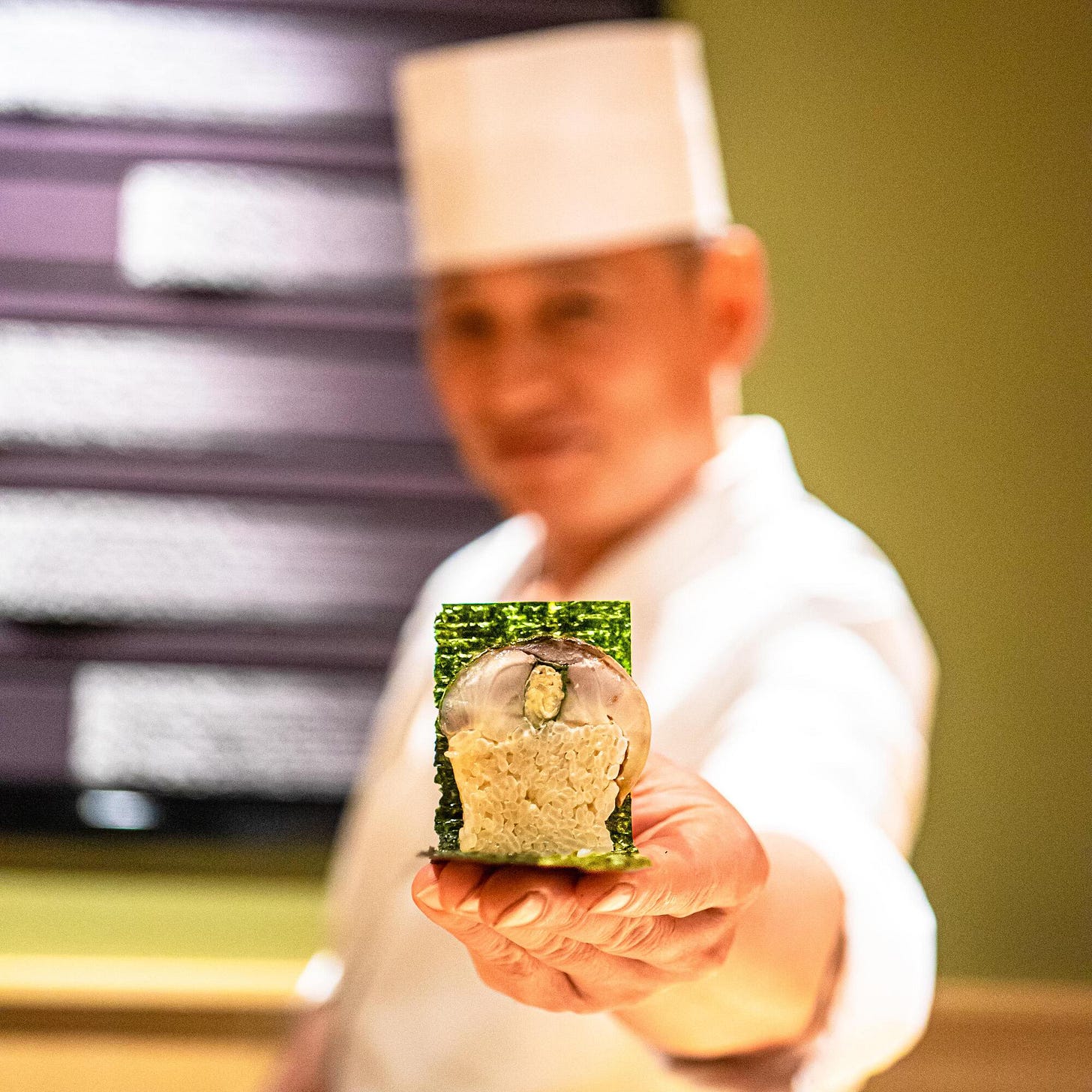
When Is It Still Sushi? And When Is It Just a Roll With Feelings?
Let me confess something up front: the first time I ate Japanese food, it wasn’t sushi. It was teppanyaki.
Not hibachi—that’s what they call it in the U.S., where dinner comes with flying shrimp, onion volcanoes, and knife tricks that feel more Vegas than Tokyo. In Mexico, back in the late ’80s, teppanyaki was quieter. No showmanship. Just a hot griddle, a chef with monk-like focus, and the smell of soy sauce hitting steel. It was controlled, restrained, and to my dad—sacred.
He loved taking us there. It was his way of feeding us culture, of saying, “This is the real thing. Pay attention.” And we did. It felt foreign, important, serious.
Then the ’90s happened.
The California roll went global. Supermarket sushi spread like a food court gospel. Cream cheese slipped through the cracks. Fusion wasn’t just accepted—it was deep-fried. And that’s when we met Sushi Itto.
It was the opposite of what my dad revered. A chain spot slinging breaded shrimp rolls with avocado, spicy mayo, watered-down soy, and yes—sometimes mango. I never loved the mango. Even as a kid, it felt like sushi trying too hard to be dessert. But everything else? I devoured it.
We begged to go there. My dad caved. Begrudgingly. “That’s not sushi,” he’d mutter, watching me and my sister tear through crunchy rolls with neon sauces. He wasn’t wrong. But we didn’t care. It was fun. It was ours.
And it wasn’t just in Mexico. I remember being in a mall in Rio de Janeiro in 1991 and ordering “sushi” from a bright little counter wedged between a burger joint and a clothing store. I got a roll with mango in it and just thought, “Oh boy, even here?” Same story, different country. I didn’t love it. Too sweet. Too weird. But I ate it. Because I was curious. Because it was new. Because back then, sushi still felt like something foreign and exciting—even when it came with fruit.
Then, a few years later, in the mid-’90s, I was in San Francisco. I ordered futomaki at a real Japanese spot. No cream cheese. No sauce. Just seaweed, rice, egg, vegetables—maybe a sliver of fish. I took a bite and thought, That’s it?
I was naive. A little fool. I didn’t understand what I was eating—only what I was missing. The fried crunch. The indulgence. The sugar rush.
Fast-forward many years, and I’m a different eater entirely.
I’ve spent the last decade and a half chasing down real sushi—authentic sushi. I’ve eaten at the best counters in LA, New York, and London. I’ve sat in front of revered shokunin like Tadashi “Yoshi” Yoshida at Yoshino in Manhattan, where every piece of fish feels like it was composed in a monastery. I’ve tasted sushi so precise, so balanced, so achingly perfect, it made me sit in silence just to process it.
I’ve evolved. I’m not the kid who thought futomaki was boring or who flinched at raw fish anymore. Somewhere along the way—bite by bite, trial and error—I trained my palate. I learned what real rice should taste like: warm, seasoned, gently tangy, holding together just long enough to disappear. I started noticing things I never paid attention to before—the angle of a cut, the temperature of the fish, the texture of nori before it wilts. I learned to appreciate restraint. To listen more than I talked. To trust the quiet confidence of a chef who doesn’t need to explain anything.
And now, finally, I’m going to Japan.

Food Moves. Food Changes. Always Has. Always Will.
Food doesn’t stand still. It migrates. It adapts. It mutates. Sometimes out of creativity. Sometimes out of survival. Sometimes just because that’s what sells.
Look at pizza. In Naples, it’s sacred—charred, chewy, minimalist. In Chicago, it’s a cheese bomb wearing a crust. Deep dish is technically pizza the way a tank is technically a vehicle. Then there’s Domino’s—spreading across the globe like a weed, redefining pizza one rubbery slice at a time.
Mexican food? Same deal. What much of the world calls “tacos” are often crunchy shells filled with ground beef, cheddar cheese, iceberg lettuce, and sour cream. To a Mexican, that’s not a taco—it’s a prank. But to millions of Americans, it’s what they grew up on. It’s comfort. It’s Tuesday night. And nostalgia, even for the wrong version, is a powerful seasoning.
And now, just to complicate things further—Chipotle is opening in Mexico. Yes, that Chipotle. The burrito bowl empire born in Denver, forged in fast-casual fire, and often blamed for feeding the world a skewed idea of what Mexican food is. Unsurprisingly, the reaction on Mexican social media has been loud and brutal. Outrage. Memes. A collective national side-eye.
But here’s the thing: Chipotle isn’t trying to be “authentic.” It never was. It’s a brand. A ritual. A flavor profile that means something to a lot of people—just maybe not to us Mexicans. I’m not a fan, but I understand why it works. It has a market. It makes certain people happy.
Will it succeed in Mexico? Maybe. Maybe not. Starbucks, for instance, faced skepticism when it entered Italy, a country with a deeply entrenched coffee culture. Yet, by adapting its offerings and creating inviting spaces, it has managed to establish a presence with over 40 stores, appealing to both locals and tourists . In Colombia, despite initial concerns about competing with the beloved Juan Valdez brand, Starbucks has expanded to over 50 stores, indicating a successful adaptation to the local market .
These examples show that while initial reactions may be resistant, there's potential for integration if the brand respects and adapts to local tastes and cultures.
Authenticity Is a Feeling, Not a Set of Rules
So what makes a dish authentic?
Is it ingredients? Geography? Technique? Or is it emotion?
My dad’s teppanyaki outings were about reverence. He wasn’t just feeding us—he was teaching us. And I’m grateful for that. But I also can’t deny that those absurd, overstuffed rolls at Sushi Itto are burned into my childhood memories.
They weren’t “real.” But they were mine.
Even the ones I didn’t love—like the mango roll in Rio—they were part of my journey. And if you follow the trail of crunchy, spicy, fried sins long enough, you eventually reach something quieter. Something truer. Something that doesn’t need sauce to sing.
I know now that authenticity isn’t just about rules. It’s about meaning. About care. About someone giving a damn.


When Does It Become Something Else?
At some point, fusion stops being imitation and becomes identity.
Tex-Mex is its own cuisine. So is Chinese-American. So is Japanese curry. They’re not cheap knockoffs—they’re the real deal, born from new homes, new needs, and new palates.
Maybe the shift happens when people start cooking it that way on purpose—not out of ignorance, but out of love. When it’s not trying to be something else. When it just is.
Deep dish pizza still goes by the same name, but nobody in Naples would recognize it. And that’s fine.
Maybe cream cheese rolls stopped being sushi a long time ago. Or maybe they were never sushi to begin with. But they stuck. Because they mattered to someone.

What Really Matters
Here’s what I’ve learned: I’ve had sushi that changed me—quietly, profoundly, wordlessly. Meals so precise they felt like memories being carved in real time. I’ve also had sushi that made me want to punch a menu.
But some of the most meaningful food I’ve eaten wasn’t “authentic.” It was comforting. Familiar. Honest. I think about Washington, D.C., where most “Mexican” restaurants aren’t Mexican at all—they’re Salvadoran-owned, run by cooks from a country with a different flavor language entirely. But Mexican food is what sells, so they adapt. And somewhere along the way, the tacos start looking suspiciously like pupusas—thicker masa, softer edges, fillings that lean more Central American than norteño.
As a Mexican, I’ll be honest: I found it a little offensive when I first lived there. It felt like someone pretending to speak my language, but getting the accent all wrong. Still, I’ve come to understand its place. It’s not a scam—it’s survival. A kind of culinary code-switching. Fusion born not from creativity, but from necessity.
A sushi master in Tokyo might spend decades perfecting temperature and cut. A Salvadoran cook in D.C. might be pressing masa from memory while shaping it into something that’ll pass as a taco. And both, in their own way, are feeding someone with care.
So maybe the better question isn’t is this authentic?
Maybe it’s why does this exist—and who is it feeding?
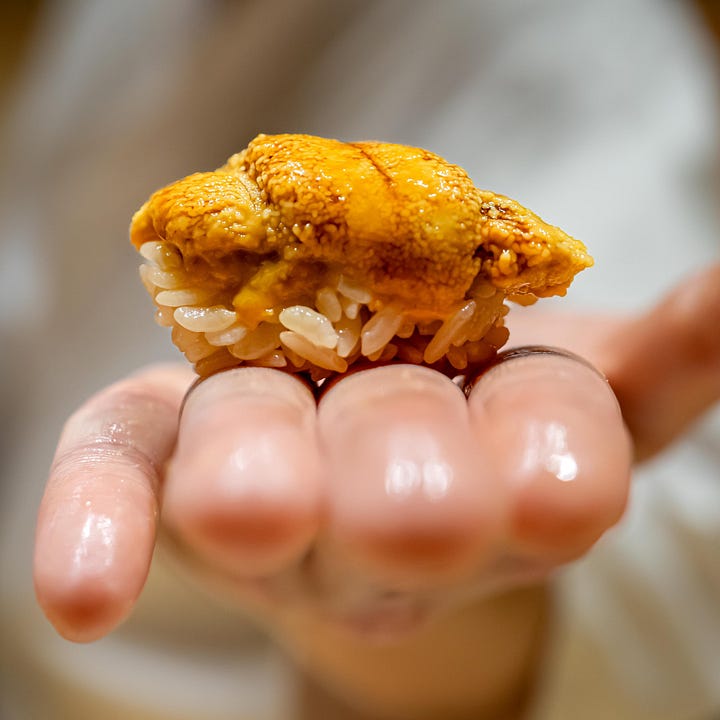
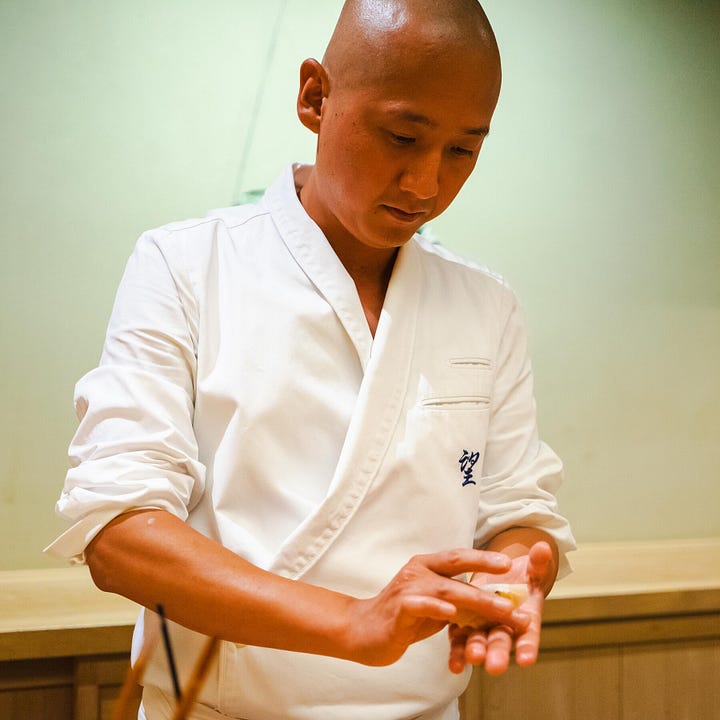
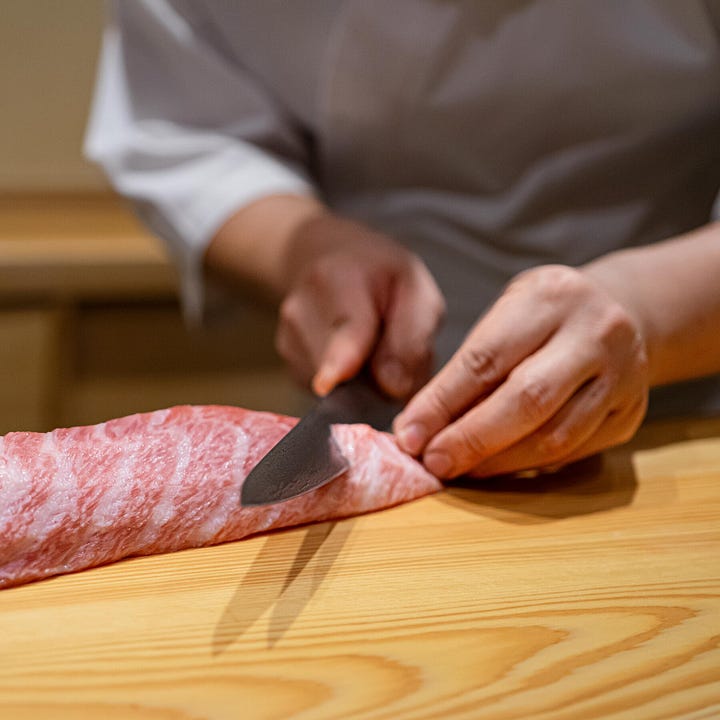
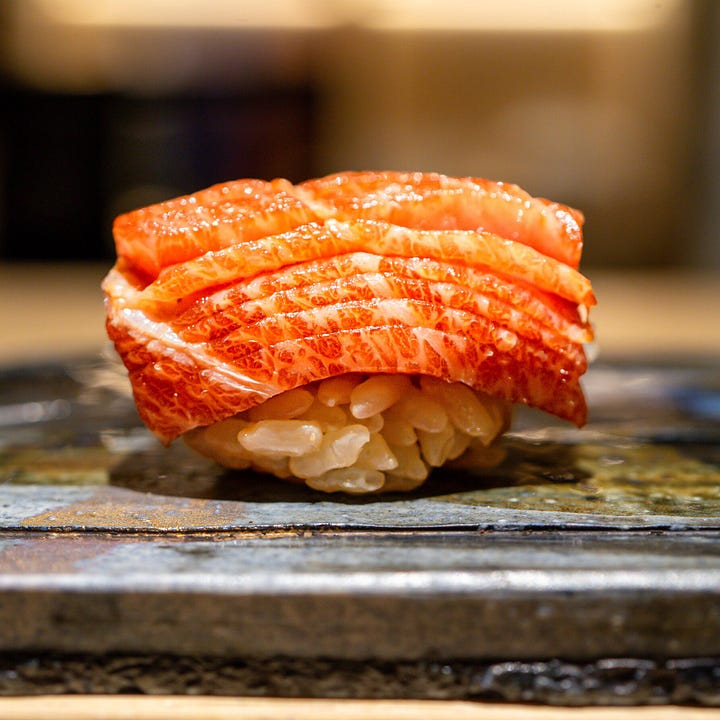
Full Circle: Japan and the Roll That Started It All
Now, I’m going to Japan. I’ve been building up to this for decades.
And I know—I know—that I’ve already eaten sushi as close to perfect as it gets. I’ve sat at the best counters, eaten fish flown in that morning, tasted rice adjusted to the humidity of the day. I’ve paid dearly for the privilege.
But still—this trip will feel different.
Not because it’ll be better. Because it’ll be complete.
Because place matters. Because ritual matters. Because eating sushi in Japan—even at a small, unpretentious spot tucked behind a train station—will feel like coming home to a country I’ve never lived in, but have always traveled toward.
And here’s the truth: I wouldn’t be here without the supermarket sushi. Without the cream cheese rolls. Without Sushi Itto. As far removed as they were from traditional Edomae, they gave me a foundation—however shaky. They sparked my curiosity. They laid the groundwork for the obsession that followed. And who knows? If I hadn’t tasted that first “wrong” version of sushi, maybe I would’ve never gone looking for the right one.
And that’s the thing.
Both versions of these foods—the traditional and the transformed—have a place. A deep-dish pizza isn’t Neapolitan, but it’s still pizza. A Taco Bell crunchy shell isn’t a taco al pastor, but it’s still food that shaped someone’s childhood. A spicy roll might not be sushi in the purist sense, but for some people, it’s the version that feels like home. The one they crave. The one that makes them happy.
They’re not the same. They’re not equal. But they’re both valid.
Because food is memory. Food is survival. Food is joy.
And maybe my dad would be proud—not just because I’ve learned to appreciate the “real” thing, but because I never stopped being curious about what made it real in the first place.
That’s food.
It evolves. It seduces. It betrays you. It brings you back.
Even if “back” is half a world away, on a quiet street in Tokyo, where a man in a white coat places a perfect piece of sea urchin in front of you…
…and says nothing at all.
Gracias, papá.




